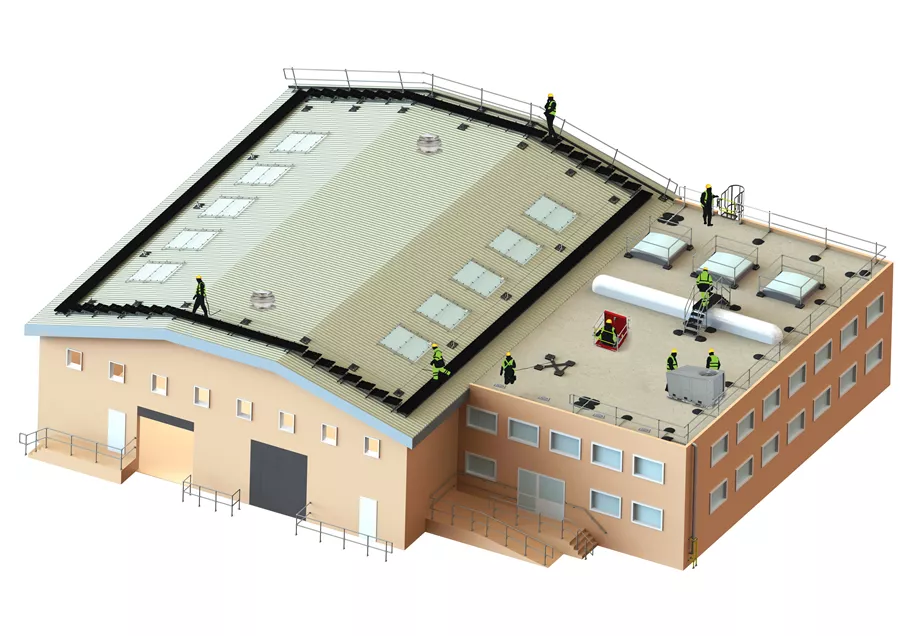
You are visiting the Canada Kee Safety website from United States. Would you like to go to the United States site?

“To everything, there is a season,” and every season differs from the others. Spring brings blossoms, summer brings heat, autumn brings falling leaves, and winter brings rooftop hazards that workers do not face at other times of the year.
Snow and ice make roofs slippery and increase the risk of accidents and injuries. Snow can also hide pipes, ducts, conduits, and other trip hazards from the unsuspecting worker. Although it can be blustery any time of the year, high winds can make a slippery rooftop even more dangerous.
The response, however, is not to hibernate. Essential maintenance still needs to be performed. Employers and building owners can take steps to provide proper fall protection and reduce the chances of their workers experiencing an injury.

Begin with a “risk assessment” – identify the potential hazards:

Whether you access the roof through a hatch, stairwell, or ladder, the common thread is that you should have safety guardrails at the access point with a self-closing gate. This will help prevent the worker from falling backward when accessing the roof and provide a vital piece of fall protection equipment while working on the roof.

Traversing and working on an icy or snow-laden rooftop can be done much more easily and safely with walkways and platforms constructed of anti-slip aluminum or nylon steps and platform floors with sturdy, corrosion-resistant galvanized steel or aluminum frames. They provide fall protection by demarking a clear path, elevating the worker above a slippery surface, and allowing for drainage of snow and ice. There are several easy-to-install, versatile solutions:
• Roof Steps – designed for a wide range of roof types with pitches up to 35 degrees.
• Roof walkways with guardrails – add the extra fall protection of safety railing, which can be installed on one or both sides of the walkway.
• Roof crossovers – enable workers to access different roof levels and avoid ductwork, piping, cables, and other trip hazards.
• Work platforms – are custom-designed for safe, ergonomic servicing of rooftop systems and equipment. They are more stable and productive than using ladders to access heights.

The roof edge is the most significant hazard area during any season, but in the winter, when the roof’s surface can be more slippery, or winds can be crueler, the threat is amplified. For flat and low-sloped roofs, a compliant perimeter guardrail system will “collectively” protect one or more workers simultaneously without needing personal fall protection equipment or special training.

Since a skylight may not support the weight of even one worker, skylights are classified as a “hole in the roof.” They can present additional hazards in the winter. If snow obscures a skylight, the worker might accidentally step onto it. Snow and ice should be removed from skylights to prevent damage to the skylight – and let the light shine in.
Skylight guardrails or screens should be installed to protect workers when approaching skylights or removing snow and ice. Skylight guardrails, which can be configured as needed, are typically constructed from galvanized steel or aluminum. Skylight screens, available in several formats, are available in galvanized or stainless steel. All these materials are corrosion resistant.

Vertical and horizontal lifelines are standard fall protection and fall arrest systems that protect individual workers—though a horizontal lifeline system can protect up to three at once. Lifelines require worker training and inspections before and after use.
The grounding component of a lifeline is a fall arrest anchor. Fixed roof anchors can be installed permanently on various roof types. Mobile roof anchors can be positioned where needed on a flat or low-slope roof.

Preparation for rooftop safety in the winter should include certified training, especially when lifelines will be used to perform tasks.
PFPE Competent Inspector Training teaches the roles and responsibilities for conducting inspections of Personal Fall Protective Equipment (PFPE) under current legislation and equipment standards.
Rescue After a Fall teaches the skills, knowledge, and competence to conduct a rescue after a worker has fallen and is suspended by their lanyards.
Fall protection systems are essential but do not discount common sense. Check the weather forecast, or better yet, look outside. Are conditions too difficult to take the risk? Is the task urgent, or can it be completed another day?
If the roof is accessed, are the workers appropriately dressed to withstand the weather and conditions, including slip-resistant, insulated footwear? If there is snow, are there shovels, rakes, and brooms to move the snow safely out of the way? Do you need ice-melting pellets?
Be safe this winter and look forward to the other seasons.

We don't just focus on products. We deliver solutions. Our team is trained to spot hazards and develop a full plan for protecting your rooftop.